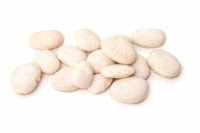Beans are low in fat and loaded with nutrients, and we'd probably eat more of them if they weren't also loaded with flatulence-producing enzymes. One help to reduce gas is to change the water from time to time while you're soaking or cooking the beans. Pouring off the water helps gets rid of the indigestible complex sugars that create gas in your intestine. It also helps to cook the beans thoroughly, until they can be easily mashed with a fork. Most bean connoisseurs prefer dried beans, but canned beans are also available. These don't need to be cooked, but they tend to be saltier and less flavorful than reconstituted dried beans.
If you get overwhelmed at the grocery store (or cannery) when choosing beans for your food storage, here are a few favorites and how to use them:
Navy beans are also known as pea beans, a small white bean used in navy bean soup, baked beans, casseroles and ethnic dishes. A large portion of the crop is used in canned beans and tomato sauce.
The pinto bean is a variety of the red kidney bean which was first cultivated by the Indians of South and Central America. The pinto bean is grown in Southeastern Utah and Southwestern Colorado. It is used in Mexican dishes, such as refried beans and chili.
The kidney bean is large, has a red color and is kidney shaped. They are frequently used for chili con carne, in salads, baked beans, dips, main dishes and casseroles.
Black beans are also known as turtle beans and are used in Oriental and Mediterranean cooking. A rich, thick soup is made with black beans in the Southern United States.
There are two classes of lima beans—large seeded, or Ford-hook type, and small seeded, known as baby limas. In the southern part of the United States, the lima bean is called butter bean. Used for casseroles, main dishes, and vegetable side dishes.
Chick peas are also known as garbanzos in Spanish-speaking countries. Chick peas have a nut-like flavor and keep their shape well when cooked. Chick peas are used on salads and in casseroles and soups. A favorite for using chick peas is making hummus.
Black eyed beans are also known as black-eye peas or cow peas, in different areas of the country. They are primarily used as a main dish vegetable and are traditionally served on New Year’s Day in the South as a token of good fortune during the new year. They are small, oval-shaped, and creamy white with a black spot on one side. Also good roasted with cajun seasonings.
The Japanese use these small red beans to make sweet red bean paste, but they're also good in rice dishes or salads. Adzuki beans are sweet and relatively easy to digest, so they won't make you as gassy as other beans. They also don't take as long to cook. Substitutes: black adzuki beans OR red kidney beans OR Tolosana beans.
Split peas are green and yellow in color. In grocery stores, split peas come cleaned in one-pound packages. Large quantities in bulk might also be available in specialty shops. Split peas are commonly used in soups.
Lentils
 As the name implies, the lentil looks like a double lens. Lentils are dried on the plant and go through a number of processes to remove any extraneous plant materials. Therefore, they always need to be looked at carefully before cooking. Lentils are grown in the United States and come in various shades of brown. Almost all are grown at an altitude over 2,000 feet in Washington and Idaho. Good in soups and salads, or “baked lentil” dishes.
As the name implies, the lentil looks like a double lens. Lentils are dried on the plant and go through a number of processes to remove any extraneous plant materials. Therefore, they always need to be looked at carefully before cooking. Lentils are grown in the United States and come in various shades of brown. Almost all are grown at an altitude over 2,000 feet in Washington and Idaho. Good in soups and salads, or “baked lentil” dishes.
Selection
Dry beans are available in several forms, packaged in transparent packages, loose, or canned. The following are important factors in selection:
1. Bright, uniform color. Color will vary with the variety of bean, but loss of color usually indicates long storage time.
2. Uniform size. Uniformity of size will result in a more evenly cooked product since small beans cook faster than large beans.
3. Freedom from defects. Cracked seed coats, foreign material, and pinholes caused by insects are signs of a low quality product.
About one-third of all dry beans are officially inspected. Federal grades are generally based on shape, size, color, damage and foreign material. The packaged beans, which are on the grocery shelf, are normally the highest grades.









No comments:
Post a Comment